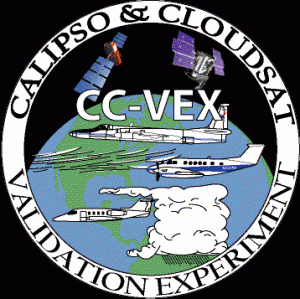CALIPSO-CloudSat Validation Experiment

The CALIPSO-CloudSat Validation Experiment (CC-VEx) was conducted between July 24 and August 14, 2006. The purpose of the experiment was to provide in-atmosphere observations of cloud and aerosol that were coincident with the CALIPSO-CloudSat satellite measurements. These observations were needed to evaluate the sensitivity, calibration, and alignment of the satellite measurements, as well as provide some initial knowledge on microphysical properties of clouds and aerosols for validation data.
CALIPSO is a joint mission between NASA and the French space agency, Centre National D’etudes Spatiales (CNES), and CloudSat, a partnership between NASA, the Canadian Space Agency (CSA), and the US Air Force. Both missions were designed to provide insights into the role clouds and atmospheric aerosols and their vertical structure have on the Earth’s weather, climate, and air quality. CALIPSO’s payload consists of a two-wavelength polarization-sensitive lidar, an infrared imaging radiometer, and a wide field-of-view camera, while CloudSat’s payload consists of a state-of-the-art cloud profiling radar operating at 94GHz. CALIPSO and CloudSat were launched together on April 28, 2006, on a Delta II launch vehicle and flew in close formation in the international A-Train satellite constellation.
To validate satellite observations, three aircraft were deployed during CC-VEx: the NASA ER-2, the Weather Modification Inc. LearJet, and the NASA B-200 King Air aircraft. Each aircraft was equipped with its own instrumentation and measurements: the ER-2 included a lidar, radar, and imaging spectrometer similar to the CALIPSO and CloudSat instrument suite, the LearJet provided cloud particle measurements, and the King Air supported a new and more sophisticated lidar design than CALIPSO.
Warner Robbins Air Force Base in Georgia was the base of operation for the ER-2 aircraft and LearJet, while NASA Langley was host to the King Air aircraft. During CC-VEx, 12 comparison flights with the two spacecraft were flown by the ER-2 which includes four flights at night, seven flights were conducted by the LearJet, and the B-200 King Air underwent three flights. The CC-VEx experiment collected observations in and above thick and thin cirrus, mid-layer clouds, precipitating clouds, clouds with ice, water, and mixed phased particles, as well as aerosols along the satellite track. Due to the early satellite validation studies from CC-Vex measurements, improvements were made in the quality of CALIPSO and CloudSat data products, which were first released in late 2006. The CALIPSO data products are archived at the Atmospheric Sciences Data Center and the CloudSat data products are archived at Colorado State University.